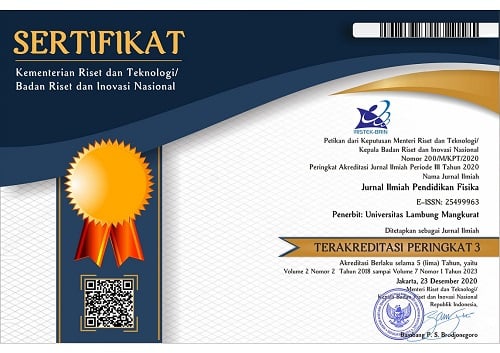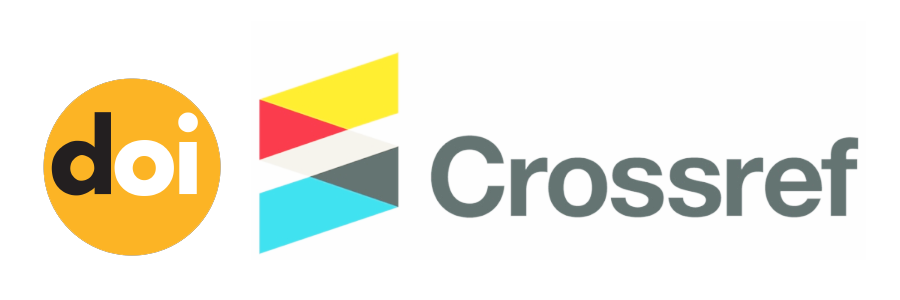Development of Student Worksheets Based on Guided Discovery Learning Assisted by Tracker Video Analysis on Mechanical Energy Conservation Material
Abstract
Student worksheets based on guided discovery learning assisted by a tracker video analysis on mechanical energy conservation materials were developed to provide experience in learning physics on conservation material mechanical energy. This research aims to produce a product in the form of the student worksheets based on guided discovery assisted by tracker video analysis. Studying this is research and development (R&D), using the ADDIE model, which consists of 5 stages: analysis, design, development, and implementation. This study uses quantitative data and qualitative data. Quantitative data results from the validation sheet and questionnaire responses of students and teachers. Then, qualitative data will be collected as suggestions, comments, and criticism from the validator regarding the development of the student worksheets. Data collection techniques using interviews and observations. The instrument used is a validation sheet for three validators: media, material, and language experts. This research was held at the Riyaluul Ulum High School. The research subjects were physics teachers and students of class X MIPA. The sample consisted of 130 students who were taken using simple random sampling and two teachers. Data analysis technique using descriptive statistics to determine validity and practicality. The results showed that the average value of media validation was 83% and categorized as very valid, material validation was 82% and categorized as very valid and language validation was 77% and categorized as valid. The results of the practicality assessment by students is 80% with the category of practical, and by the teacher is 86% very practical. The results of this study state that it can be used and implemented in the learning process.
Keywords
Full Text:
PDFReferences
Asmirani, U., Putra, A., & Asrizal, D. (2013). Pengaruh lks berbasis sains teknologi masyarakat terhadap kompetensi siswa dalam pembelajaran ipa fisika di kelas viii smp n 1 kubung kabupaten solok. Pillar of Physics Education, 1(1).
Agraini, S. D. (2020). Desain lkpd berbasis model pembelajaran penemuan terbimbing (guided discovery) untuk meningkatkan self efficacy matematis peserta didik smpn 16 kota jambi. (Skripsi). Program Studi Pendidikan Matematika, FKIP, Universitas Jambi.s
Artiningsih, A., & Nurohman, S. (2020). Analysis of investigative skills based on the use of tracker video analysis for 21th century skill. Journal of Science Education Research, 3(2), 81-86.
Budi, A. S., Sari, S. W., Sanjaya, L. A., Wibowo, F. C., Astra, I. M., Puspa, R. W., ... & Pertiwi, W. A. (2021, November). PhET-assisted electronic student worksheets of physics (eSWoP) on heat for inquiry learning during covid. Journal of Physics: Conference Series, 2104(1), 012030. IOP Publishing.
Darling-Hammond, L., Flook, L., Cook-Harvey, C., Barron, B., & Osher, D. (2020). Implications for educational practice of the science of learning and development. Applied developmental science, 24(2), 97-140.
Deboer, G. E. (2011). Investigating students’ understanding of energy transformation, energy transfer, and conservation of energy using standards-based assessment items. https://www.researchgate.net/publication/265148820
Desimaris N. A., Bare, Y., & Hadi, J. P. S. (2022). Pengembangan lkpd berbasis guided discovery pada materi pewarisan sifat kelas ix smp. Jurnal Ilmiah Wahana Pendidikan, Desember, 2022(24), 589–602. https://doi.org/10.5281/zenodo.7495949
Habibbulloh, M. (2014). Penerapan metode analisis video software tracker dalam pembelajaran fisika konsep gerak jatuh bebas untuk meningkatkan keterampilan proses siswa kelas x sman 1 sooko mojokerto 1. Jurnal Pendidikan Fisika Dan Aplikasinya (JPFA), 4(1). http://rudy-unesa.blogspot.
Hardini, R. R., Pujayanto, P., & Ekawati, E. Y. (2013). Pengembangan bahan ajar ipa terpadu berbasis salingtemas untuk smp kelas vii dengan tema ekosistem air tawar. Jurnal Materi dan Pembelajaran Fisika, 3(1).
Hernawan, A. H., Permasih, & Dewi, L. (2008). Panduan pengembangan bahan ajar. In Depdiknas Jakarta.
Lau, K. H., Lam, T., Kam, B. H., Nkhoma, M., Richardson, J., & Thomas, S. (2018). The role of textbook learning resources in e-learning: A taxonomic study. Computers & Education, 118, 10-24.
Misbah, M., Dewantara, D., Hasan, S. M., & Annur, S. (2018). The development of student worksheet by using guided inquiry learning model to train student's scientific attitude. Unnes Science Education Journal, 7(1).
Mulyadi, D., Wahyuni, S., & Handayani, R. (2016). Pengembangan media flash flipbook untuk meningkatkan keterampilan berfikir kreatif siswa dalam pembelajaran ipa di smp. Jurnal Pembelajaran Fisika, 4(4).
Nadia, N., Mastuang, M., Misbah, M., & Ibrahim, M. A. (2021). Developing learners’ autonomy-oriented physics teaching materials to enhance students' science process skills. JIPF (Jurnal Ilmu Pendidikan Fisika), 6(3), 185-197.
Nurdyansyah, M. (2018). Pengembangan bahan ajar modul ilmu pengetahuan alambagi siswa kelas iv sekolah dasar.
Pahrudin, A., Misbah, M., Alisia, G., Saregar, A., Asyhari, A., Anugrah, A., & Susilowati, N. E. (2021). The Effectiveness of science, technology, engineering, and mathematics inquiry learning for 15-16 years old students based on k-13 indonesian curriculum: the impact on the critical thinking skills. European Journal of Educational Research, 10(2), 681-692.
Prastowo, A. (2016). Panduan kreatif membuat bahan ajar inovatif. Diva Press. Yogyakarta.
Pratiwi, N., & Yulkifli, Y. (2019). Peningkatan kompetensi keterampilan peserta didik berbantuan lkpd berbasis model discovery learning pada materi fluida. Indonesian Journal of Science and Mathematics Education, 2(1), 130–139. https://doi.org/10.24042/ijsme.v2i1.4219
Pribadi, B. A. (2016). Desain dan pengembangan program pelatihan berbasis kompetensi implementasi model ADDIE. Kencana.
Rezeki, S., & Ishafit. (2017). Pengembangan lembar kerja siswa (LKS) berbantuan media simulasi dengan modellus untuk pembelajaran kinematika di sekolah menengah atas. Prosiding SNPF (Seminar Nasional Pendidikan Fisika).
Riduwan. (2007). Skala pengukuran variabel-variabel penelitian. In Alfabeta, Bandung.
Risa, E., Hakim, L., Ratnaningdyah, D., & Sulistyowati, R. (2021). Pengembangan lkpd berbasis problem solving berbantuan software tracker untuk meningkatkan keterampilan pemecahan masalah di sma. Jambura Physics Journal, 3(1). https://doi.org/10.34312/jpj.v3i1.8705
Risda, G., Arifuddin, M., Misbah, M., & Saukani, M. (2023). Developing teaching materials on elasticity and hooke's law oriented towards learner autonomy to train science process skills. Journal of Environment and Sustainability Education, 1(2), 64-71.
Riyana, C., & Pd, M. (2008). Peranan Teknologi Dalam Pembelajaran. http://www.cepiriyana.blogspot.comhttp://www.projectcepi.blogspot.com
Sadjati, I. M. (2012). Pengembangan bahan ajar.
Sucipta, Ahman, E., & Budiwati, N. (2018). Metode guided discovery learning terhadap tingkat berpikir kritis siswa dilihat dari motivasi belajar. Indonesian Journal of Economics Education, 1(1).
Sugiyono. (2017). Metode penelitian kuantitatif, kualitatif dan R&D. Bandung: Alfabeta.
Suwartaya, S., Anggraeni, E., Rujiyati, Saputra, S., & Setyaningsih, D. A. (2020). Panduan pengembangan bahan ajar pembelajaran jarak jauh (ba-pjj) sekolah dasar. Dinas Pendidikan Kota Pekalongan.
DOI: https://doi.org/10.20527/jipf.v8i2.9106
Refbacks
- There are currently no refbacks.
Indexed by: Jurnal Ilmiah Pendidikan Fisika is licensed under a creative commons attribution-share alike 4.0 international license
Statistics Counter |
















